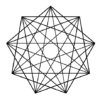
The 8-pointed star (Octagram) is an iconic symbol for religions and cultures across the globe. Its usage dates back centuries, and it can still be found on national flags and religious insignia today. For each group that uses it, the 8-pointed star symbolizes something fascinating and different—and that’s what we’ll be delving into in this article.
Let’s begin by taking a look at the 2 main types of the 8-pointed star. We will then explore the various meanings associated with the star and also look at 16 ancient 8-pointed star symbols from across the world and their symbolism.
Types of 8-Pointed Star
There are two methods for drawing the 8-pointed star, and based on these methods, the star can be classified into the following types:
- 8/2 Eight-Pointed Star – consisting of two overlapped squares
- 8/3 Eight-Pointed Star also called the Unicursal 8-pointed star as this can be drawn in a single stroke without lifting the pen.
In addition, there are also a few variations of the 8/3 unicural star. All these types are shown in the image below:

Let’s see how you can draw the 8/2 Eight-Pointed Star:
To draw the 8/2 Eight-Pointed Star, you star at the topmost point of an Octagon and connect every 2nd point to form the 1st square. You can then join the remaining points to form the 2nd square as shown in the image below:

Let’s see how you can draw the 8/3 Eight-Pointed Star:
To draw the 8/3 star, you start at the top vertex and then connect every 2nd point till the star is complete as shown in the image below:
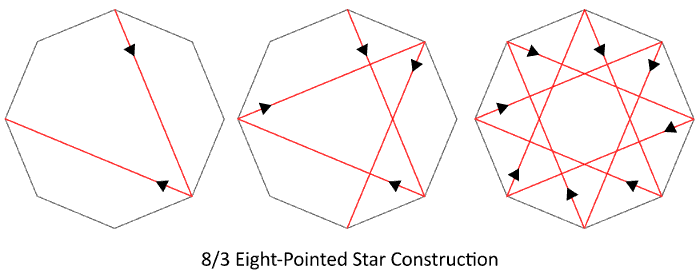
This star is unicursal in nature and can be drawn in a single stroke without lifting the pen. This star also has many variations as discussed earlier.
11 Spiritual Meanings Associated with the 8-Pointed Star (Octagram)

Here are 10 important symbolisms associated with the 8-pointed star.
1. Light/Illumination
For several cultures and religions, the 8-pointed star is linked to the planet Venus, the first light visible in the morning sky. In some cultures, the star is also associated with the sun. This is why the eight-pointed star symbolizes the victory of light over darkness.
It also symbolizes illumination and spiritual enlightenment which is about bringing into consciousness (or shedding light on) that which is unconscious or hidden.
2. Creation
The 8-pointed star has been associated with creation and the birth of the universe across various cultures. The star’s symmetrical design suggests the balance of opposites such as light and dark, masculine and feminine, and so on, which is the fundamental aspect of creation. Similarly, the number 8 is linked to infinity with no beginning or end which is again linked to creation. This is because creation is seen as an ongoing and infinite process of growth and expansion.
Even from a scientific perspective, it has been found that a fertilized human egg first divides into 8 cells and, thereby, 8 energy channels—which form the foundations of an embryo and a human life. Thus, patterns of nature involving the number 8 are inherent to biology and creation.
3. Solar & Lunar events
In many cultures, the 8-pointed star is used to symbolize the 8 major Solar and Lunar events, This includes the 8 phases of the moon (new moon, waxing crescent, first quarter, waxing gibbous, full moon, waning gibbous, third quarter, and waning crescent) and the 8 major solar events in a year which include the 4 seasons, the winter and summer solstices, and the spring and autumn equinoxes. Thus the 8-pointed star serves as a reminder that we are all connected to the natural rhythms of the universe and inspires us to live life in tune with the laws & rhythms of nature.
4. Guidance & Direction
The North Star, also known as Polaris, has been used for navigation since ancient times due to its fixed location in the northern sky. Many cultures have associated the North Star with the 8-pointed star. In Christianity, the Bethlehem star that led the three kings to the birthplace of Jesus is often depicted as an 8-pointed star. Similarly, the star is also related to the Compass Rose which traditionally represented guidance and safe passage for travelers. All of these factors make the 8-pointed star a powerful symbol of guidance and direction.
5. Protection
Many cultures across the world have used the 8-pointed star as an apotropaic symbol for protection against negative energy and to ward off the evil eye. The eight points of the star also correspond to the eight cardinal directions (north, south, east, west, as well as the points in between), and hence it is believed that the star offers all-encompassing protection against evil coming from any direction. It’s no surprise that the 8-pointed star has a rich history of being used as a pictogram on doorways and as an amulet/talisman for protection.
6. Renewal & New Beginnings
The number 8 often alludes to resurrection, salvation, and new beginnings. This partly has to do with the fact that the figure 7 denotes completion. (For instance, while 7 represents a complete calendar week, the 8th day involves a new beginning.) Also as per Christianity and the old testament, God created the universe in 6 days and on the 7th day, he rested. This means, the 8th day is the day associated with a new beginning.
Symbolizing new beginnings, cycles of death and rebirth, and infinite potential, the number 8 gives great meaning to the 8-pointed star.
7. Prosperity & Good Luck
In many cultures, like for instance, in Hinduism, the 8-pointed star is linked with concepts of Ashta-mangala (8 auspicious objects) and Ashta-Lakshmi (8 forms of goddess Lakshmi who is the goddess of wealth, prosperity, and good fortune. Even in numerology, 8 is considered a powerful and influential number, associated with material success and achievement.
8. Balance & Harmony
The 8-pointed star is often associated with balance due to its symmetrical design. The eight points are evenly spaced, and each point represents a different direction, color, and element. In many cultures the star is made of two overlapping squares, one representing the divine masculine and the other representing the divine feminine. The squares represent the intricate balance and harmony that exists between these opposing energies that are vital to life and creation. Also, the number 8 being an even number is associated with balance.
9. Infinity & Cycle of Life
The number 8 when viewed horizontally represents the concept of infinity. The star also has eight points that form an endless loop, emphasizing the idea of infinity. In some cultures, the star is also associated with the concept of eternity, representing the never-ending cycle of birth, death, and rebirth.
10. Happiness
Since the 8-pointed star is linked to the light and the sun, it is also linked to happiness and cheer.
Of course, specific usages of the 8-pointed star vary from culture to culture. In Nordic tradition, the star is used to invoke magic. In Buddhism, the 8-pointed star inspires a pathway to Enlightenment. In Malta, the star decorates buildings, flags, and currency as a proud reminder of a period of the nation’s past. Let’s discover more about all these usages by taking a look at 16 ancient octagram symbols from across cultures.
11. Infinity

The 8/2 Eight-Pointed Star, as depicted in the image above, can be drawn infinitely. Within the star lies its own replica, allowing for an endless continuation. Consequently, the 8/2 star symbolizes infinity and the timeless essence of life and the soul.
16 8-Pointed Star (Octagram) Symbols Found Across Cultures & Their Meaning

The following are 16 examples of 8-Pointed Star symbols found across various ancient cultures and religions and their associated symbolism.
1. Star of Ishtar – Mesopotamian Civilization

Dating back as early as 2000 BC, the Star of Ishtar (which is an Eight-Pointed Star) symbolized the ancient Mesopotamian goddess Ishtar. Ishtar was the goddess of love and war and therefore closely associated with the planet of love, Venus. Of all the gods and goddesses, Ishtar was high-ranking. Mesopotamians in the city of Babylon regarded her as the ‘queen of heaven.
The link between the Star of Ishtar and Venus is significant. As is common of ancient civilizations, the Mesopotamians recognized Venus as the morning and evening star — the first light to be seen at dawn and the last light at dusk.
Being the first and last light afforded Venus high esteem—and, by association, the Star of Ishtar. On Mesopotamian artifacts, the Star of Ishtar can be found engraved alongside the sun and moon, which—given their celestial prominence—were also worshiped as gods.
2. Wiccan Wheel of the Year
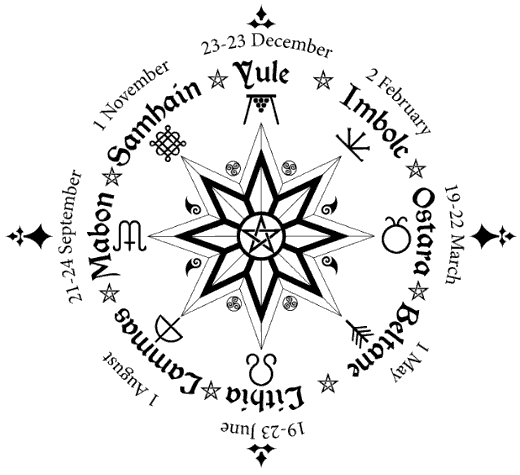
The Wiccan Wheel of the Year gained its name in recent times but manifests a tradition that extends across history. As a star set in a circle, the wheel’s 8 points denote the 8 major solar events that occur throughout the year. This includes the 2 equinoxes (Spring Equinox & Autumn Equinox), and 2 solstices (Summer Solstice & Winter Solstice), and the beginning of the four seasons – Spring, Summer, Autumn, and Winter.
All these events are celebrated by Pagans and have specific names as follows:
- Yule – Winter Solstice (20 – 23 December)
- Imbolc – Beginning of Spring (1st February)
- Ostara – Spring Equinox (19 – 22 March)
- Beltane – Beginning of Summer (1st May)
- Litha – Summer Solstice (19 – 23 June)
- Lughnasadh – Beginning of Autumn (1st August)
- Mabon – Autumn Equinox (21 – 24 September)
- Samhain – Beginning of Winter (1st November)
At the time of each festival, Pagans partake in celebratory rituals to pay tribute to what each festival represents. A fine example is the Imbolc festival of springtime, whose Gaelic-deriving name (Oimelc) signifies the milk drunk by newborn lambs. Celebrated with ritual bonfires, Imbolc is a time to shake off the winter, lay plans for new beginnings, and enjoy the onset of fertility in the natural world.
In addition to the Solar events, the Wiccan Wheel also represents the major Lunar events. These include the 8 moon phases which are – new Moon, waxing crescent, first quarter, waxing gibbous, full Moon, waning gibbous, third quarter, and waning crescent.
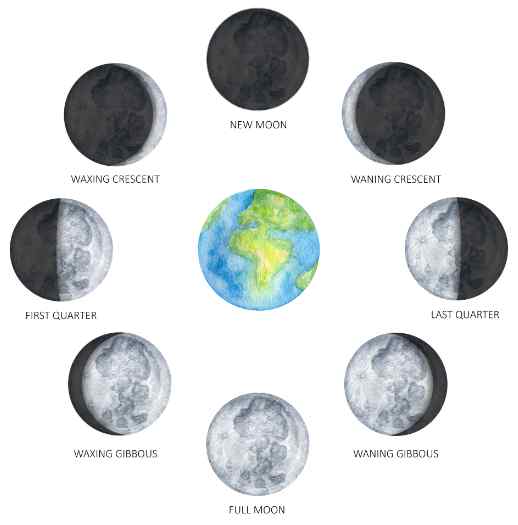
As a guide through the cycles of nature, the circular shape of the Wheel of the Year is also said to be a metaphor for the infinite cycles of death and rebirth on Earth.
3. Dharma Chakra – Buddhism

The Buddhist representation of the 8-Pointed Star is the Dharma Chakra. For Buddhists, the Dharma Chakra represents self-knowledge and knowledge of the truth. It also embodies the Buddha and his teachings; early Buddhist art features the Dharma Chakra as a stand-in for the Buddha, who famously promoted the symbol in his first sermon.
Adding to the Dharma Chakra’s value, each of its 8 spokes has a meaning. Respectively, these are: the right livelihood, the right action, the right effort, the right intention, the right concentration, the right mindfulness, the right speech, and the right view. If Buddhists abide by these conditions, they are said to be following the Noble Eightfold Path, a path that paves the way to Enlightenment.
Interestingly, the Dharma Chakra’s circular shape may also illustrate the Buddhist concept of samsara—the universe’s infinite cycles of death and rebirth.
Given that the Dharma Chakra is loaded with meaning—and linked to Buddhists’ highest spiritual goal, Enlightenment—it is apt that the symbol has stood the test of time. While it is visible in the earliest Indian and East Asian art, it still stands out today as a detail on the emblems of Mongolia, India, Sri Lanka, and beyond.
4. Egyptian 8-pointed Star

The eight-pointed star was a significant symbol in ancient Egyptian culture as it was closely associated with the creation of the world. According to Egyptian mythology, the world was created by eight gods, four male and four female, who represented the four elements of water, air, darkness, and infinity. The names of these gods and their associated elements are as follows:
- Nun and Naunet (water)
- Amun and Amaunet (air/invisibility)
- Kek and Kauket (darkness/spirit)
- Heh and Hauhet (infinity/ether)
Together these gods were known as Ogdoad and they represented the balance of opposites and infinity. As per the myth, these gods created the Sun God Ra (light/fire being the 5th element) from the first waters and thus laid the foundation of the material world.
5. Kaheksakand – Estonia

In Estonia the eight-pointed star is called Kaheksakand (kaheksa=8 and kand=star). Considered a sacred symbol the Kaheksakand is believed to have powerful protective properties and is often used as a talisman for protection against the evil eye and negative energy.
Also, since the symbol is associated with the morning star Venus and because it can be drawn in a single stroke without lifting the hand (refer image below), it is regarded as an auspicious symbol of love, long life, good luck, happiness, renewal, and fertility. For these reasons, this symbol is often used in traditional Estonian wedding ceremonies as a symbol of positive energy, good luck and prosperity.

Overall, the Kaheksakand is an important symbol in Estonian culture and is revered for its protective and life-affirming qualities. In Latvia, this symbol is known by the name – Auseklis.
6. Mi’kmaq Star

In Northern Canadian Mi’kmaq communities the Eight-Pointed Star is associated with the power and light of the Sun and holds great spiritual significance. The star represents hope and protection and is often drawn in doorways and thresholds to ward off evil and negative energy. The locals call the star Wejkwapeniaq which translates to, “the coming of the Dawn”.
The star is often depicted in four different colors: red, black, white, and yellow, which symbolize balance with oneself and Mother Earth, as well as harmony and unity between the four races of people.
The Mi’kmaq Star also signifies the four directions, with white representing the land of ice and snow in the north, yellow representing the east where the Sun rises, red representing the warmer south, and black representing the west, where the sun sets to give us night.
Doubled to eight points, the star represents the concept of “The Great Mystery” which is a common theme in Mi’gmaq cosmology. The doubled points imply that there is always something more than what meets the eye, and that is the presence of a spiritual dimension in everything. Mi’kmaq people seek to understand and connect with the Great Mystery through spiritual practices such as prayer, ritual, and meditation.

Also, as shown in the image above, the Mi’kmaq Star is an ancient symbol that has been proven by the discovery of the Star’s Petroglyph in Bedford, Canada. The petroglyphs were carved using stone tools and pre-date the arrival of Europeans, indicating their great age.
7. Compass Rose

The compass rose has been used for centuries to represent the eight directions, and it is closely related to the eight-pointed star. The eight points of the compass represent the eight directions of north, south, east, and west, as well as the points in between, such as northeast, southeast, northwest, and southwest. This symbolizes interconnectedness, unity, and balance.
The compass rose, while commonly used for navigation, has also been utilized for spiritual guidance. Each direction on the compass holds a specific spiritual meaning and is associated with a primal element. These associations are as follows:
- The North indicates wisdom and is associated with the element of Earth.
- The East indicates Love/Masculine energy and is associated with the element of Air.
- The South indicates Faith/Trust and is associated with the element of Fire.
- The West indicates introspection and feminine energy and is associated with the element of Water.
By aligning oneself with these qualities, one can navigate the journey of life with greater purpose and direction.
8. Star of Bethlehem – Christianity

In Christianity, the 8-Pointed Star is known as the Star of Redemption or the Star of Bethlehem. The star is often associated with the birth of Jesus Christ and the journey of the three wise men to find him. This is why the star symbolizes hope, divinity, miracles, direction, and guidance.
In addition, the star is also associated with new beginnings, regeneration, and resurrection. This is because, in the Bible, the number 7 is considered to represent completion as God created the world in 7 days. So the 8th day and the number 8 signifies a new beginning or a fresh start.
9. Native American 8-Pointed Star

The Native American 8-pointed star primarily symbolizes hope, guidance, and protection.
The symbol has an inner star and an outer star. The 4 points of the inner star symbolize the four cardinal points – East, West, North, and South and the four seasons. The 4 points of the outer star symbolize the four major solar events – 2 Solstices and 2 Equinoxes.
The symbol also has a circle around it that symbolizes the never-ending love and protection of God from all directions and throughout all seasons. It also serves as a constant reminder of everything that God has given us to help and guide us in this material realm.
10. Lakshmi Star – Hinduism

The Lakshmi star is an auspicious Hindu symbol that represents the goddess Lakshmi, who is the goddess of wealth, prosperity, and good fortune. The symbol is created by two overlapping squares, with the top square turned at a 45-degree angle, resulting in an eight-pointed star.
The eight points of the star are said to represent the 8 forms of goddess Lakshmi (known as Ashta Lakshmi) which are as follows:
- Adi Lakshmi – New Beginnings
- Dhana Lakshmi – Wealth
- Dhanya Lakshmi – Nourishment
- Gaja Lakshmi – Influence
- Santana Lakshmi – Fertility
- Dhairya Lakshmi – Courage
- Vijaya Lakshmi – Victory
- Vidya Lakshmi – Knowledge
The points also represent the Ashta Dikpala who are the eight guardians who guard and protect the eight directions of the universe. The eight deities are Indra (east), Agni (southeast), Yama (south), Nirriti (southwest), Varuna (west), Vayu (northwest), Kubera (north), and Ishana (northeast).
In addition, the star points are also said to symbolize the Ashta-mangala, which are the eight auspicious symbols in Hinduism, Buddhism, and Jainism. These symbols include the conch shell, wheel, umbrella, lotus, vase, two fish, victory banner, and endless knot. These symbols are believed to bring good fortune, peace, and prosperity.
They also represent the 8 chakras, 8 planets as per Hindu astrology and the 8 Vasus, who are deities associated with natural elements like water, earth, fire, etc.
- Bhumi (Earth)
- Samudra (Water)
- Agni (Fire)
- Vayu (Wind)
- Amsuman (Sun)
- Akasha (Sky/Ether)
- Varchas (Moon)
- Prabhāsa (Stars)
The overlapping squares also represent the concept of duality, with the horizontal square symbolizing the physical world and the vertical square symbolizing the spiritual realm. Together, they represent the union of the two worlds.
The Lakshmi star is a powerful symbol of abundance and spiritual prosperity. It is often used in Hindu homes and businesses to invite the blessings of Lakshmi and to promote prosperity, good luck, and good fortune.
11. Maltese Cross – Malta

In Malta and overseas, the Maltese Cross has had multiple connotations over the centuries. But there is a common thread: predominantly, it stands for heroism and courage.
The Maltese Cross began its life as an emblem for the Knights Hospitaller, a medieval military order of monks. For them, the 8 points of the Cross illustrated 8 values: gratitude, honesty, piety, honor, solidarity, loyalty, courage, and respect for the Church.
Present in Malta from 1530 to 1798, the Knights Hospitaller wove their Cross into Maltese public life. It came to adorn everything from palaces to churches, to coins, and silverware. The legacy of this can be seen in Malta today: buildings, currency, jewelry, and tourist paraphernalia all bear the honorable Maltese Cross. It has become a symbol of Malta.
Notably, the values associated with the Maltese Cross also live on. Descended from the Knights Hospitaller, today’s Sovereign Military Order of Malta maintains 8 virtuous meanings for the Cross. What’s more, the Maltese Cross was, and still is, used to denote military and humanitarian organizations worldwide. This proves its strong global legacy as an emblem representing courage.
12. Vegvísir and the Helm of Awe – Nordic
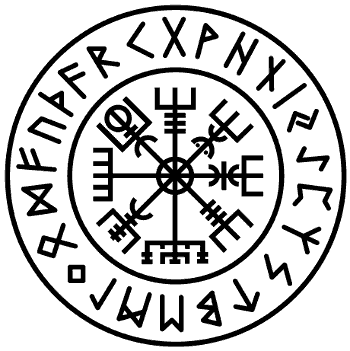
In Norse mythology, Vegvísir and the Helm of Awe are both powerful symbols that have eight arms, and each arm has a unique shape.
Translating as ‘way finder’, the Vegvísir was carried (mainly by explorers and seafarers) to provide guidance on journeys, especially to avoid getting lost in bad weather. Be it as ritual symbols or jewelry, the Vegvísir is still used today—often to provide existential help with navigating life and attaining goals. The eight arms of the Vegvísir symbol are said to represent the eight winds or directions, and the symbol was believed to help the bearer navigate through storms and rough seas. It was also thought to offer protection and serve as a guide towards one’s true path.

The Helm of Awe, meanwhile, had a more formidable role: it was worn as a symbol on the forehead during battle to deflect magical curses, strike fear in enemies, and convey invincibility to the wearer. In addition, bearing the Helm of Awe was meant to deter warriors from abusing their power. Each arm is said to represent a different type of power or protection against negative energies and malevolent spirits.
The Helm of Awe’s trident shaped arms were inspired by runes known as Algiz (shown in the image below), which were duly connected to the idea of repelling enemies.

Like the Vegvísir, the Helm of Awe remains a powerful talisman for people today, worn to inspire courage and grit in the face of challenges.
13. Selbu Star – Nordic

Stemming from the Norwegian town of Selbu, the Selbu Star depicts a blooming rose—hence its alias, the Nordic Rose. Most commonly, the Selbu Star features as a pattern on Nordic-inspired textiles, and it carries a rich cultural heritage.
Unknown to many, this rose pattern arose in ancient times; it can be found on European textiles dating back centuries. It was in 19th-century Norway, however, that it took on a new meaning. A girl in the Norwegian town of Selbu knitted mittens featuring the rose design, and they were so popular that the pattern came to feature on clothing garments throughout Norway.
Significantly, the Nordic Rose, or Selbu Star, also meant more than a flower to Norwegians. It was considered to resemble a snowflake, which spoke to the hearts of a nation accustomed to colder climes. It so came that, on some special occasions, Norwegians would gift each other garments bearing the Selbu Star.
Overseas, the Selbu Star gained further renown. Norwegian textile exporters capitalized on its resemblance to a snowflake and the prevalence this would have in the foreign imagination. To this day, across the world, garments featuring the Selbu ‘snowflake’ are worn as references to Nordic culture and life.
14. Bagua Trigram – Chinese

In Chinese philosophy, the Bagua symbol that consists of 8 trigrams is associated with the 8-pointed star. It is a symbol that represents the fundamental principles of reality.
The trigrams consist of eight unique combinations of three lines: either a full line (yang) or a broken line (yin). The Full Line represents masculine energy (Yang) and the broken line represents feminine energy (Yin). These two basic lines represent the yin-yang concept, which symbolizes opposing yet complementary forces in the universe that are the basis of creation.
The Bagua’s eight trigrams represent the different combinations of three elements of yin or yang nature, making it the maximum number possible. Four of these trigrams are considered yang, representing masculine energy, and the remaining four are considered yin, representing feminine energy.
Each of the eight trigrams symbolizes a natural phenomenon or element. These are as follows:
- Heaven (Qian, representing the element of metal)
- Lake (Dui, representing the element of marsh or swamp)
- Fire (Li, representing the element of fire)
- Thunder (Zhen, representing the element of wood)
- Wind (Xun, representing the element of wood or tree)
- Water (Kan, representing the element of water)
- Mountain (Gen, representing the element of earth)
- Earth (Kun, representing the element of earth)
It is believed that understanding the eight trigrams of Bagua can provide a person with the ability to comprehend the past, present, and future.
15. Rub-el-Hizb – Islam

The Rub-el-Hizb is an ancient Arabic symbol made of two overlapping squares, with the top square rotated by 45 degrees to form an octagram. The symbol is known as khatim or khatim-sulayman, which means “seal of prophet Sulayman (the Biblical King Solomon).
According to Islamic tradition, the eight-pointed star was used by Sulayman to seal letters and messages that he sent to other rulers and leaders. The star was believed to hold great power and protected the messages from any interference or tampering. It was also thought to symbolize Sulayman’s wisdom, strength, and leadership.
Etymologically, the name Rub-el-Hizb also relates to the symbol’s usage in the Koran. Rub means ‘quarter’ and Hizb means ‘group’, with Rub-el-Hizb meaning ‘divided into quarters’. This describes how the Rub-el-Hizb is used in the Koran; it divides up sections of it to facilitate reading.
Rub-el-Hizb is also seen as a symbol of protection and is believed to ward off evil and bring good luck and blessings.
16. Star of Arauco

The Star of Arauco belongs to the Mapuche indigenous people of Chile and Argentina. It is also known as the Wünelfe, meaning ‘bringer of dawn’. This refers to the star representing the shining planet Venus, which the Mapuche celebrated as the first light visible in the dawn sky.
The Star of Arauco has great significance in Mapuche culture. It can be found engraved on the kultrún, a highly sacred drum used in shamanic rituals. On this drum, the Wünelfe appears alongside the sun and moon, confirming its prominence in Mapuche spirituality.
Fascinatingly, the Wünelfe may also symbolize the cinnamon flower, with its 8 points signifying 8 petals. Cinnamon trees, cinnamon bark, and their flowers are, like the kultrún, sacred to the Mapuche and used in shamanic healing.
So cherished was, and is, the 8-pointed star that it became an emblem of the Mapuche community. Medieval Mapuche warriors fighting Spanish invaders bore the Wünelfe emblazoned on flags—flags that partly inspired the Chilean national flag of today.
The Star of Arauco was also valuable to Mapuche laborers and lovers. As both groups often prayed for success in the early morning, they were considered protected by the star known as the bringer of dawn’s light.
Conclusion
The 8-pointed star is more than just a symbol – it’s a doorway to a world of ancient wisdom and spiritual power. Across cultures and throughout history, this potent symbol has served as a beacon of balance, light, and cheerfulness, reminding us of the natural cycles of life and the importance of living in harmony with the rhythms of the universe.
If you feel drawn to the 8-pointed star, consider incorporating it in your life for protection and good fortune. Whether worn as an amulet or simply carried as a reminder, this powerful symbol has the ability to guide you toward your true goals, balance, fulfillment, and spiritual enlightenment.




